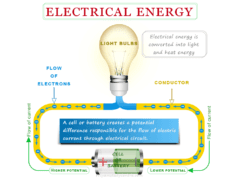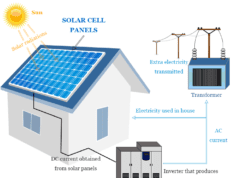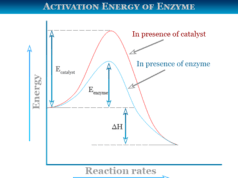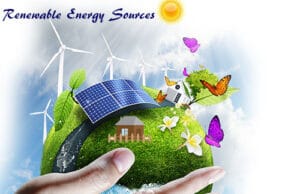Wind Energy Generation
Wind energy or wind power is a natural renewable energy source that uses in wind turbines for the generation of electricity. It is a clean source of energy that does not impact our environment like burning fossil fuels. The kinetic energy of wind is transformed into electrical energy through a wind turbine. Wind turbines work opposite like a fan. A fan uses electricity to make wind but wind turbines use the wind to make electricity. Today, wind power is mostly used to generate electricity in small-scale wind energy production for household electric power generation and wind farms that contain many individual wind turbines for electric power transmission. The prime objective of using small-scale wind power generation systems or wind farms is to generate electrical power with a low carbon footprint or reduce environmental pollution.
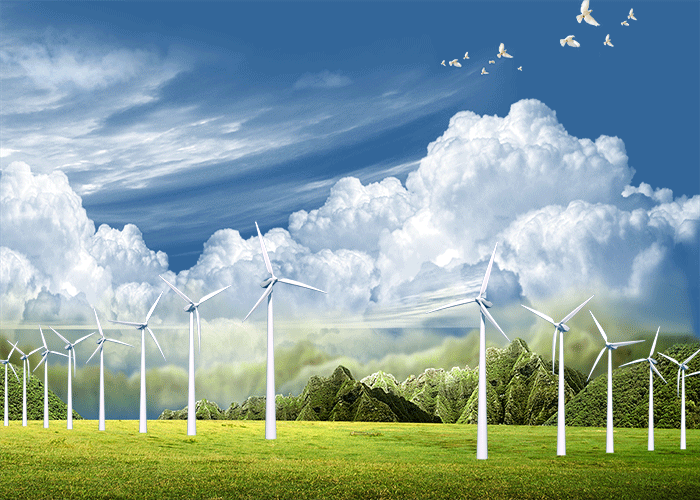
How is Wind Generated?
Wind power is another form of solar energy because solar radiation is the main facts for wind flow on the earth. Solar radiation does not warm the earth’s surface equally. Some regions are warmer than others.
The air present in warmer areas creates low-pressure areas while the air in colder areas creates high-pressure areas. The difference in pressure in these two areas causes wind flow from one region to another region.
Wind Turbine
A wind turbine is a device that turns the kinetic energy of wind into rotational energy. In wind farms, a large number of turbines are installed to generate electricity. Terefore, it is an increasingly important source of intermittent renewable energy.
Rotor
A wind turbine uses the aerodynamic force from the rotor blades for the production of electricity. The rotor blades in turbines work like an airplane wing or helicopter rotor blade.
When wind flows across the blade, the air pressure on one side of the rotor blade decreases. The difference in air pressure across the two sides of the turbine blade causes the rotor to spin.
Multiplier
The rotor connects to the turbine, either directly or through a series of gears to speed up the rotation. The multiplier may increase the rotational speed from 30 rpm to 1500 rpm.
Generator
The generator in a wind turbine converts the mechanical energy of rotation into electrical energy.
The electricity produced from each of the wind turbines present in a wind farm is linked together by underground cables. It carries the electricity to the substation.
At a substation, medium-voltage electric current obtained from the wind turbine is increased in voltage with a transformer. This high voltage electricity is connected to an electric power transmission system and transported to homes, factories, schools, etc.
Uses of Wind Energy
Historically, wind energy can be used to operate sails, windmills, and windpumps.
Sails
A sail is a tensile structure made from fabric or other polyester cloth and uses for sailing craft, sailing ships, boats, windsurfers, ice boats, and sail-powered land vehicles by wind power. It usually contains a three- or four-sided shape.
Windmills
A windmill is also a very old technology that uses wind power mainly to mill grains, drive machines, or move water. It is a structure that converts wind power into rotational energy by means of vanes called sails or blades.
Windpumps
A windpump is a type of windmill which used for pumping water from wells or draining water from low-lying areas of land. The water pumping by windpump technology uses mainly for drinking or irrigation. In many places in the world, windpumps are still used for village water supply or irrigation.
Small-Scale Wind Energy
Small-scale wind power is an energy generation system that produces up to 50 kW of electricity. Individuals may purchase small-scale wind power systems to reduce their dependence on grid electric power for economic reasons. It also reduces carbon footprint.
Small-scale wind turbines have been used for household electric power generation. It may be conjugated with battery storage over many decades in remote areas. These small turbines are used primarily for generating electricity to use on-site rather than transmitting energy over the electric grid from central power plants or wind farms. It is a small-scale alternative to solar energy that provides clean renewable energy sources to rural homes, farms, and businesses.
The urban setting of small-scale wind power projects can be found in several buildings in New York City. They have capped their roofs with Gorlov-type helical wind turbines.
Off-Grid Wind Turbines
Like solar energy systems, off-grid turbines are not connected to the electrical transmission grid. These turbines are generally installed in areas where connecting to the grid would be expensive.
The simplest off-grid systems use direct current (DC) and provide power to devices like telecommunications equipment and water pumps.
These simple wind power generation systems may use battery storage to provide backup power when the wind is not blowing. By adding an inverter to an off-grid system, the electricity can be converted to alternating current (AC). It allows the turbine to supply power for AC appliances.
There are a number of commercial and residential applications for off-grid wind energy systems. Rural houses and farms located far from population centers, and commercial oil platforms commonly use small-scale wind turbines because they are a cheaper power source of electricity.
Grid-Connected Systems
In recent years, the small-scale wind market has shifted from off-grid systems to more grid-connected systems. Grid-connected small-scale wind energy generation system is now the most common type of small wind energy generation system.
Many new turbine models contain an in-built inverter system. Therefore, these wind energy generation systems are compatible with the AC electric grid upon installation.
Many businesses and factories use grid-connected small turbines to lower their carbon footprint and reduce their electricity bills. Homes and farms also use a small wind power generation system for the same reasons. It is a cheaper option than solar panels. If a grid-connected small turbine has a large enough generating capacity, it may be possible to sell excess electricity to earn money.
Wind Farms
A wind farm or windfarm is an assembly of wind turbines at a given location to capture wind energy for the production of bulk electricity for a grid. Therefore, a large wind farm may contain several hundred individual wind turbines distributed in an area. The land between the turbines may be used for irrigation or other purposes.
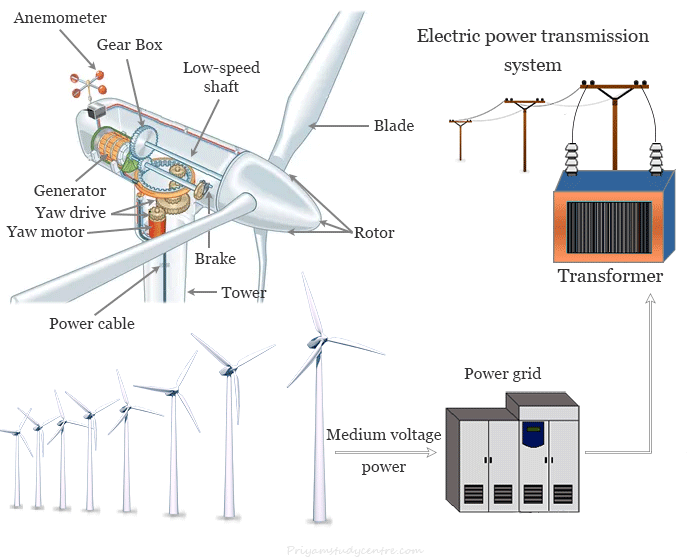
Individual turbines of wind farms are interconnected with a medium voltage power collection system and communications network. This medium-voltage electric current is transformed to high voltage by a transformer present in a power station. Therefore, it can be connected to the high voltage electric power transmission network to supply electricity for homes, factories, schools, etc.
Types of Wind Energy
Currently, we use two types of wind energy generation systems depending on the location of the wind turbines.
Onshore Wind Energy
Onshore wind energy farms are responsible for producing electricity through wind turbines located on land. It is an inexpensive source of electric power. The onshore wind project is cheaper than thermal power plants and new gas plants.
Offshore Wind Energy
Offshore wind energy farms are located in large bodies of water, usually the sea. It has a higher and more constant speed than the wind turbine located on land due to the absence of barriers. These installations can generate more and constant electricity than land-based projects but the construction and maintenance costs are considerably higher.
Advantages and Disadvantages
Advantages of Wind Energy
- Wind power is a cost-effective source of energy because it is fuel free source of energy
- It creates jobs because a wide number of workers and wind turbine technicians are needed to operate wind power projects.
- Like solar energy, it is a clean source of energy that does not pollute the air of our environment. In power plants, the combustion of fossil fuels such as coal or natural gas emits nitrogen oxides and sulfur dioxide which causes acid rain, smog, or the greenhouse effect.
- It is greatly beneficial for the economy in rural areas.
- A fraction of land is needed for the operation of wind turbines. Therefore, farmers and ranchers can continue to work on such land.
Disadvantages of Wind Energy
- Good land-based wind sites are located in remote locations or far from cities. Therefore, transmission lines are needed to bring the electricity from the wind farm to the city.
- Energy harnessed by wind turbines is not a dispatchable source of power. The availability of wind power is based on the wind blowing.
- The wind turbines used for electricity generation may cause noise pollution but they have relatively little impact on our environment compared to conventional power plants.
- Wind power plants can impact birds and bats because they have been killed by flying into spinning turbine blades.

